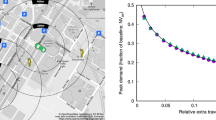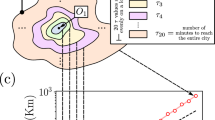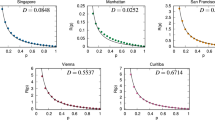Abstract
Information and communication technologies have opened the way to new solutions for urban mobility that provide better ways to match individuals with on-demand vehicles. However, a fundamental unsolved problem is how best to size and operate a fleet of vehicles, given a certain demand for personal mobility. Previous studies1,2,3,4,5 either do not provide a scalable solution or require changes in human attitudes towards mobility. Here we provide a network-based solution to the following ‘minimum fleet problem’, given a collection of trips (specified by origin, destination and start time), of how to determine the minimum number of vehicles needed to serve all the trips without incurring any delay to the passengers. By introducing the notion of a ‘vehicle-sharing network’, we present an optimal computationally efficient solution to the problem, as well as a nearly optimal solution amenable to real-time implementation. We test both solutions on a dataset of 150 million taxi trips taken in the city of New York over one year6. The real-time implementation of the method with near-optimal service levels allows a 30 per cent reduction in fleet size compared to current taxi operation. Although constraints on driver availability and the existence of abnormal trip demands may lead to a relatively larger optimal value for the fleet size than that predicted here, the fleet size remains robust for a wide range of variations in historical trip demand. These predicted reductions in fleet size follow directly from a reorganization of taxi dispatching that could be implemented with a simple urban app; they do not assume ride sharing7,8,9, nor require changes to regulations, business models, or human attitudes towards mobility to become effective. Our results could become even more relevant in the years ahead as fleets of networked, self-driving cars become commonplace10,11,12,13,14.
This is a preview of subscription content, access via your institution
Access options
Access Nature and 54 other Nature Portfolio journals
Get Nature+, our best-value online-access subscription
$29.99 / 30 days
cancel any time
Subscribe to this journal
Receive 51 print issues and online access
$199.00 per year
only $3.90 per issue
Buy this article
- Purchase on Springer Link
- Instant access to full article PDF
Prices may be subject to local taxes which are calculated during checkout




Similar content being viewed by others
References
Berbeglia, G., Cordeau, J. F. & Laporte, G. Dynamic pick-up and delivery problems. Eur. J. Oper. Res. 202, 8–15 (2010).
Laporte, G. The vehicle routing problem: an overview of exact and approximate algorithms. Eur. J. Oper. Res. 59, 345–358 (1992).
Baker, B. M. & Ayechew, M. A. A genetic algorithm for the vehicle routing problem. Comput. Oper. Res. 30, 787–800 (2003).
Yang, J., Jaillet, P. & Mahmassani, H. Real-time multivehicle truckload pick-up and delivery problems. Transport. Sci. 38, 135–148 (2004).
Clare, G. L. & Richards, A. G. Optimization of taxiway routing and runway scheduling. Proc. IEEE Intell. Transport. Syst. 12(4), 1000–1013 (2011).
Bloomberg, M. R. & Yassky, D. New York City Taxicab Factbook http://www.nyc.gov/html/tlc/downloads/pdf/2014_tlc_factbook.pdf (New York City Taxi and Limousine Commission, 2014).
Santi, P. et al. Quantifying the benefits of vehicle pooling with shareability networks. Proc. Natl Acad. Sci. USA 111, 13290–13294 (2014).
Tachet, R. et al. Scaling law of urban ride sharing. Sci. Rep. 7, 42868 (2017).
Alonso-Mora, J., Samaranayake, S., Wallar, A., Frazzoli, E. & Rus, D. On-demand high-capacity ride-sharing via dynamic trip-vehicle assignment. Proc. Natl Acad. Sci. USA 114, 462–467 (2017).
Rosenberg, T. It’s not just nice to share, it’s the future. NY Times Opinionator https://perma.cc/89YT-VHVF (2013).
Sundararajan, A. From Zipcar to the sharing economy. Harvard Business Review https://hbr.org/2013/01/from-zipcar-to-the-sharing-eco (2013).
Mitchell, W. J., Borroni-Bird, C. E. & Burns, L. D. Reinventing the Automobile: Personal Urban Mobility for the 21st Century (MIT Press, Cambridge, 2010).
Botsman, R. & Rogers, R. What’s Mine is Yours: The Rise of Collaborative Consumption (HarperCollins, New York, 2010).
Handke, V. & Jonuschat, H. Flexible Ridesharing (Springer, Berlin, 2013).
United Nations Environment Programme UNEP 2010 Annual Report; https://www.unenvironment.org/resources/annual-report/unep-2010-annual-report (UNEP, Nairobi, 2011).
Barth, M. & Boriboonsomsin, K. Real-world carbon dioxide impacts of traffic congestion. Transp. Res. Rec. 2058, 163–171 (2011).
Spieser, K. et al. in Road Vehicle Automation (eds Meyer, G. & Sven Beiker, S.) 229–245 (Springer, 2014).
Boesch, F. T. & Gimpel, J. F. Covering the points of a digraph with point-disjoint paths and its application to code optimization. J. Assoc. Comput. Mach. 24, 192–198 (1977).
Hopcroft, J. & Karp, R. An n (5)/(2) algorithm for maximum matching in bipartite graphs. SIAM J. Comput. 2, 225–231 (1973).
Roughgarden, T. Selfish Routing and the Price of Anarchy (MIT Press, Cambridge, 2005).
Acknowledgements
P.S., M.M.V. and C.R. thank all sponsors and partners of the MIT Senseable City Laboratory including Allianz, the Amsterdam Institute for Advanced Metropolitan Solutions, the Fraunhofer Institute, Kuwait-MIT Center for Natural Resources and the Environment, Singapore-MIT Alliance for Research and Technology (SMART) and all the members of the Consortium. The research of S.H.S. was supported by USA NSF grant numbers DMS-1513179 and CCF-1522054.
Reviewer information
Nature thanks G. Casey, V. Knoop and the other anonymous reviewer(s) for their contribution to the peer review of this work.
Author information
Authors and Affiliations
Contributions
P.S. defined the problem, designed the solution and algorithms, and contributed to the analysis and paper writing. M.M.V. designed and performed the analysis, developed models and simulations and wrote the paper. G.R. contributed to the algorithm design, implemented the algorithms and helped with the analysis. S.H.S. contributed to writing. C.R. supervised the research and contributed to writing.
Corresponding author
Ethics declarations
Competing interests
The authors declare no competing interests.
Additional information
Publisher’s note: Springer Nature remains neutral with regard to jurisdictional claims in published maps and institutional affiliations.
Extended data figures and tables
Extended Data Fig. 1 The effect of the upper bound δ on trip connection time.
a, Plot showing the minimum fleet size and the vehicle void ratio as a function of the upper bound used on the trip connection time, δ. For increasing values of δ, the minimum fleet size decreases while the void ratio increases. The results are produced by averaging over 14 days of data. b, Plot showing the yearly variation in the minimum fleet size for δ = 10 min and 20 min. This plot reports also the number of daily trips for comparison.
Extended Data Fig. 2 Intra-annual patterns.
For each day in year 2011, the number of daily trips (blue line) and the corresponding minimum fleet size (green line) are shown. Both quantities follow different weekly patterns: whereas the number of daily trips (blue line) consistently increases from Monday to Friday and drops on Sunday, the minimum number of vehicles needed to serve those trips (green line) remains substantially constant at a value of around 6,200, with a considerable drop on Sundays, when this value is reduced to about 4,000.
Extended Data Fig. 3 Intra-annual comparison between batch and on-the-fly models.
Plots showing the percentage of trips served within the next 6 min from the time the trip requests are received. In the batch model, advance knowledge of the trip information is restricted to only the next minute (batch time). The trips in each batch are assigned to the available vehicles using the online version of the network approach from the minimum fleet of size 7,440. This approach scores a consistently higher percentage (90%) than does the on-the-fly model. In the on-the-fly model, trips are assigned to the closest available vehicle. To achieve the same level of service using the on-the-fly model, the fleet size must increase by more than 30% (see Fig. 4b). The shaded region represents the 6σ variations when the vehicle warm-up phase is reinitialized 50 times, where σ = max(%)−min(%) is the difference between the percentage of served trips achieved for the runs that score maximum and minimum values for each day.
Extended Data Fig. 4 Detailed temporal patterns of the minimum fleet.
At each time during a day, each active vehicle in the minimum fleet set operates in one of three possible modes: (1) empty of passengers and on the way to pick up a passenger, (2) empty of passengers and waiting at a passenger’s pick-up location to pick up, (3) serving, with a passenger on board. The number of vehicles operating in each of these modes computed for each minute during the day follows regular daily and weekly patterns, as shown by the three coloured curves for all months in the year. The total fleet size active on the road (black-to-grey curves) demonstrates robustness, because most of the vehicles in the minimum fleet are active at all times during the day (see also Extended Data Fig. 5a and b). Different panels correspond to different months, and the colour intensity is used to differentiate different days of the week.
Extended Data Fig. 5 Vehicle-level performance in the minimum fleet assignment.
a, Stacked horizontal bar plots showing the start and end of the operation time (left and right ends of the stacked bars) for each vehicle in the minimum fleet assignment for various days of the week. The day in each panel represents results for days in the second week of each month. Vehicle active times are represented by a very thin coloured bar. The vehicles are sorted by the start of operation time, and stacking them horizontally creates each plot for each day. In all days (except for the outlier day of the second Saturday in March 2011), the patterns show high efficiency, with the majority of vehicles starting early in the day and operating until the end of the day. b, Stacked horizontal bar plots, this time representing the total operation time of the vehicle (the length of the bar). The bars are sorted based on the vehicle’s total operation time, the lowest bar corresponding to the vehicle with the longest operation time. A distinct pattern emerges on most of the weekends and on some days during the week. A substantial percentage of vehicles on most weekends operate for a short time to serve a small subset of trips, which we refer to as special-demand trips. We believe that the existence of these trips requires additional vehicles because of the way their pick-up and drop-off times and locations are distributed spatiotemporally. c, The q−q plot (where the quantile is the fraction of points below the given value) showing the percentage of trips served (vertical axis), using the vehicle-shareability minimum fleet optimization, with the percentage of vehicles represented on the horizontal axis. Vehicles are sorted on the basis of their total operation time, that is, the vehicles with longer operation times appear to the left of those with shorter operation times on the horizontal axis of these plots. Each panel corresponds to a day of the week and the curves in each panel represent all such days in the entire year (for example, all Mondays). On most weekends and consistent with the patterns observed in b, a large percentage of vehicles (between 5% and 10%) serve only a very small percentage of trips (<1%). This can be observed from the cusps appearing near the top of some of the curves.
Extended Data Fig. 6 Modelling minimum fleet size scaling with the number of trips.
a, Scatter plot showing the average operation time of vehicles with optimal dispatching for different days versus the average number of trips per vehicle for each day. The former quantity scales linearly with the average number of trips per vehicle. This holds despite the fact that the fleet size manifests a saturation pattern as the number of trips grow. b, The coefficient of proportionality between the two quantities in a is different and separates out the weekends. The coefficient is slightly lower for Saturdays (blue) and much lower on Sundays (green) compared to that of weekdays. c, Plot showing the interplay between the minimum fleet size and the number of trips for each simulated day to manifest how the fleet size changes as the number of trips greatly increases. The supersampling is done by combining the demand for similar days in two and three successive weeks. The number of vehicles shows linear growth with a ripple-like pattern of saturation and increase. d, Plot showing the interplay between the fleet size and the number of trips, as simulated using a simple bin-packing model. The oversimplified model described in Methods can still capture the ripple-like saturation/increase pattern.
Extended Data Fig. 7 Average vehicle utilization in the minimum fleet assignment versus the number of daily trips.
a, Scatter plot showing the average total time with a passenger on board per vehicle in a day versus the total number of daily trips for that day. Each point in the scatter plot represents a day. The average total time with a passenger on board, which is a measure of vehicle utilization in the minimum fleet assignment, shows an overall increasing pattern with the increase in the number of daily trips that is consistent with the fact that the minimum fleet size shows robustness. b, Scatter plot showing the average total waiting time to pick up passengers per vehicle versus the number of daily trips for each day. The average total waiting time decreases as the number of daily trips increases, which again can be interpreted as an increase in the utilization of vehicles. The observed patterns justify the unused capacity assumption used to develop the bin-packing model (see Methods and Extended Data Fig. 6).
Extended Data Fig. 8 Efficiency comparison between single and multiple mobility operators.
The optimal fleet size in the single-operator and the multi-operator mobility service in each day for the first 100 days (1 January corresponds to day index 1) in the year 2011. In the case of multiple operators, trips are randomly assigned to one of the operators in equal proportions, and network-based optimization is performed by each operator independently. The number of vehicles needed by each operator are then summed and the number for each operator is shown in a. b, Fleet-size percentage increase plot showing how the transition from a monopolistic to a oligopolistic market incurs a drop in efficiency of 4%–6% for a two-operator market, and of about 6%–10% for a three-operator market. The further increase in the number of operators leads to higher inefficiency in terms of fleet size as it moves away from the global optimum achievable in the monopolistic market to an increasingly fragmented market.
Supplementary information
Supplementary Table 1
This file contains source data for Extended Data Table 1
Source data
Rights and permissions
About this article
Cite this article
Vazifeh, M.M., Santi, P., Resta, G. et al. Addressing the minimum fleet problem in on-demand urban mobility. Nature 557, 534–538 (2018). https://doi.org/10.1038/s41586-018-0095-1
Received:
Accepted:
Published:
Issue Date:
DOI: https://doi.org/10.1038/s41586-018-0095-1
This article is cited by
-
Economic and environmental benefits of automated electric vehicle ride-hailing services in New York City
Scientific Reports (2024)
-
Spatiotemporal dynamics of traffic bottlenecks yields an early signal of heavy congestions
Nature Communications (2023)
-
Future urban transport management
Frontiers of Engineering Management (2023)
-
Construct Trip Graphs by Using Taxi Trajectory Data
Data Science and Engineering (2023)
-
Collective dynamics of capacity-constrained ride-pooling fleets
Scientific Reports (2022)
Comments
By submitting a comment you agree to abide by our Terms and Community Guidelines. If you find something abusive or that does not comply with our terms or guidelines please flag it as inappropriate.



